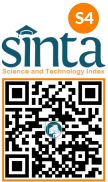Conditions of seagrass ecosystems in Ketapang Coastal Waters, West Lombok Regency
Abstract
Ketapang coastal waters, West Lombok Regency is a coastal area where seagrass ecosystems are distributed, but so far there has been no research data explaining the condition of seagrass ecosystems. This study aims to determine the condition of the seagrass ecosystem in the coastal waters of Ketapang, West Lombok Regency. This research was conducted in November 2021 which is located in the coastal waters of Ketapang, West Lombok Regency. Sampling was carried out by purposive sampling method consisting of 3 observation stations. Seagrass samples were collected using line transects and quadrant transects measuring 50×50 cm2. The parameters observed included physical and chemical water quality, as well as seagrass density and coverage. The results of water parameter measurements are still at the threshold of water quality standards. The seagrass found were Enhalus acoroides, Thalassia hemprichii, Cymodocea rotundata, and Halophila ovalis. The highest seagrass density was at station 1, 407 shoots/m2, while the lowest density was at station 3, 211 shoots/m2. The condition of the highest seagrass cover was found at station 1 and the lowest cover was found at stations 2 and 3.
Downloads
References
Ariadi H, Wafi A, Supriatna. 2020. Hubungan Kualitas Air Dengan Nilai FCR Pada Budidaya Intensif Udang Vanname (Litopenaeus vannamei). Samakia: Jurnal Ilmu Perikana: 11 (1): 44.50.
Aunurohim, & Subagio IB. 2013. Struktur Komunitas Spons Laut (Porifera) di Pantai Pasir Putih. Situbondo. Jurnal Sains & Seni ITS. 2(2): 2337-3520.
Bengen DG. 2003. Struktur dan Dinamika Ekosistem Pesisir dan Laut (Power Point). Disajikan pada perkuliahan: Analisis Ekosistem Wilayah Pesisir dan Lautan. Program Studi Sumberdaya Pesisir dan Laut. IPB, Bogor.
Dahuri R, Rais J, Ginting SP, dan Sitepu MJ. 2001. Pengelolaan Sumber Daya Wilayah Pesisir dan Lautan Secara Terpadu. PT . Pradnya Paramita. Jakarta.
English SC, Wilkinson, and Barker V. 1994. Survey manual for tropical marine resources. Australian Institute of Marine Science. Townsville. 367p.
Fahruddin M, Yulianda F, Setyobudiandi I. 2017. Kerapatan dan Penutupan Ekosistem Lamu di Pesisir Desa Bahoi, Sulawesi Utara. Jurnal Ilmu dan Teknologi Kelautan Tropis Institut Pertanian Bogor. 9 (2): 375-383.
Gosari JA & Haris A. 2012. Studi Kerapatan dan Penutupan Jenis Lamun di Kepulauan Spermonde. Torani. Jurnal Ilmu Kelautan dan Perikanan. 22 (3): 256-162.
Kadi, A. 2006. Beberapa catatan kehadiran marga sargassum di perairan Indonesia. Bidang Sumberdaya Laut. Pusat Penelitian Oceanografi Lembaga Ilmu Pengtahuan Iindonesia (P2O-LIPI), Jakarta. 71hlm.
Keputusan Menteri Lingkungan Hidup Nomor 51 Tahun 2004 tentang Baku Mutu Air Laut untuk Biota Perairan.
Lembaga Ilmu Pengetahuan Indonesia. 2014. Panduan Monitoring Padang Lamun. COREMAP-CTI. Jakarta.
Lembaga Ilmu Pengetahuan Indonesia. 2018. Status Padang Lamun Indonesia 2018. Pusat Penelitian Oseanografi. Jakarta
Madi, Rakamaly, Bertucci F, Jorissen H, and Gache C. 2020. “Importance of Intertidal Seagrass Beds as Nursery Area for Coral Reef Fish Juveniles ( Mayotte , Indian Ocean ).” Regional Studies in Marine Science 33: 100965. https://doi.org/10.1016/j.rsma.2019.100965.
Rahmawati S, Supriyadi IH, Azkab MH, dan Kiswara W. 2014. Panduan Monitoriong Padang Lamun. COREMAP CTI LIPI. Jakarta. 37 hlm.
Sudiarta IK. 2011. Kondisi dan Strategis Pengelolaan Komunitas Padang Lamun di Wilayah Pesisir Kota Denpasar, Provinsi Bali. Jurnal Bumi Lestari. 11(2), Agustus 2011: 195-207.
Suriadarma A. 2011. Dampak Beberapa Parameter Faktor Fisik Kima Terhadap Kualitas Lingkungan Perairan Wilayah Pesisir Karawang. Jawa Barat. Riset Geologi dan Pertambangan. 21(1):21-36.
Takaendengan K dan Azkab MH. 2010. Struktur komunitas lamun di Pulau Talise, Sulawesi Utara. Oseanologi dan Limnologi. 36(1): 85 95.
Tangke U. 2010. Ekosistem Padang Lamun (Manfaat, Fungsi dan Rehabilitasi). Jurnal Ilmiah Agribisnis dan Perikanan (Agrikan UMMU-Ternate). 3 (1) : 9-29.
Copyright (c) 2023 Habitus Aquatica

This work is licensed under a Creative Commons Attribution-ShareAlike 4.0 International License.
Authors submitting manuscripts should understand and agree that copyright of manuscripts of the article shall be assigned/transferred to Habitus Aquatica Journal. This work is licensed under a Creative Commons Attribution-ShareAlike 4.0 International License (CC BY-SA). Therefore, Authors and Readers are permitted to share — copy and redistribute the material in any medium or format, and adapt — remix, transform, and build upon the material for any purpose. However, they must give appropriate credit, provide a link to the license, and indicate if changes were made. If you remix, transform or build upon the material, you must distribute your contributions under the same license as the original.


















